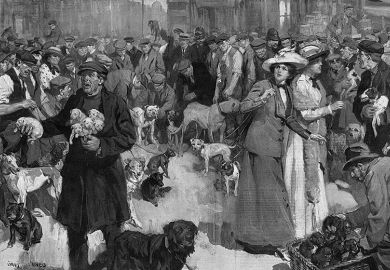This collection of Roger Scruton's occasional writings on architecture makes a consistently readable volume. He argues that the "modern movement" has had a disastrous environmental effect on our cities and advocates a return to architectural principles derived from classical prototypes. His polemic aims to provide a rationale for what many feel instinctively.
Scruton's sympathetic review of David Watkin's Architecture and Morality (included in this collection) fundamentally supports Watkin's view that architectural theorists like Gropius or Le Corbusier were so obsessed by social theory as to overlook an essential feature of architecture, namely its appearance. But whereas Watkin comes close to proposing an autonomous aesthetic, a simple matter of individual taste and cultural tradition, Scruton shows a greater awareness of the relations between taste, aesthetic education and social conditioning. In his discussion of Alberti's De Re Aedificatoria, for example, he credits Alberti with conveying the "moral reality of architecture", and "the deep and elusive connection that exists between the questions of how to build and how to live." This elusiveness may account for the two unresolved strands of thought that run through these essays. One strand is an independent, anthropomorphic aesthetic of architecture, while the other relies upon an idealised civic ethic.
Scruton's "architectural principles" are based on our nature as organism and rational being. We view buildings from a vertical position, instinctively seeking affinities with our own proportions. This, Scruton argues, explains our satisfaction in contemplating facades, particularly those that are articulated by pediments, columns, cornices or features derived from them. Vertical and horizontal articulation also creates a complex and variable interplay of light and shade. Such composition is not only aesthetically pleasing but can enable us visually to orientate ourselves. To support this assertion, Scruton compares the neo-classical Pennsylvania railroad station (now demolished) with a modern airport. In the first, the orders are used to give a sense of direction and to indicate the relative importance of the area of the station we are in. The airport with its lack of such discriminating features only induces "panic and dismay." The abandonment of this vertical emphasis in favour of its subordination to the ground plan or horizontal aspect leads to the characteristic high-rise housing or office block standing with no identifiable facade, in unlovely isolation from its surroundings. Scruton's arguments are strengthened by his discussion of individual buildings but are occasionally weakened by lapses into the method of Pugin's "Contrasts". An egregious example of relentless parti pris is a photograph of a jolly corner of Lincoln's Inn contrasted with one of an anonymous junction of two walls in front of which are two overflowing dustbins. This is captioned "a corner of the modern world". His comments on some modern buildings are also sometimes distorted by his polemical purpose. We may or may not like Sir Denys Lasdun's National Theatre, but it is no criticism of the architect to say that he has negated "the idea of a street" when his building is meant to be viewed from across a river. Such lapses apart, this is a persuasive account of the false direction taken by much late 20th-century architecture. Few would wish to quarrel with a plea for a humane eclecticism in the built environment in contrast to the totalitarian excesses of the modern movement.
But underlying Scruton's architectural principles are rather more contentious social principles. He assumes that we are living in the worst of all possible worlds, "an age of Nihilism". Clearly, from this perspective he is able to compare favourably any pre-existent age. This has been the prerogative of the laudator temporis acti through the centuries, but is, as a rule, ironically disproved by kindred spirits in the succeeding generation. While Scruton is able to propose aesthetic principles with cool rationality, his urbane discourse is intermittently disturbed by outbursts of blimpish fulmination. The Institute of Education in Bloomsbury (Lasdun again) is described as "a building as repulsive as the activities that are contained in it". Even were both (implied) statements true, there would be no necessary connection between them. In another essay, modern architecture is viewed as equivalent to "socialism, sexual liberation and a thousand other modern fads". The reader is warned that "those who defend them draw no other lesson from their failure than the thought that they have not gone far enough." The relationships between aesthetics and ethics which we are elsewhere assured are "deep and elusive" become shallow and obvious. Nor do they quite correspond to the realities of the urban environment. The exemplary preservation of Islington's terraces and squares and the jumble of high-rise blocks in the City of London do not provide evidence that Scruton's detestation of socialism or his approval of the spontaneous free market economy will give rise to the architectural environment he prefers.
These essays bring us uncomfortably close to what Geoffrey Scott identifies as the "ethical fallacy". Because Scruton admires Roman architecture, he is constrained to depict a Rome which, in its moral essence, would be unrecognisable to Tacitus or Gibbon. He writes: "One may naturally doubt that the civic virtues which inspired the glories of Roman architecture, and which produced such a harmony between the private and the public in all aspects of government and law could either be renewed or widely appreciated in our equalising age." A Britain universally housed by Quinlan Terry or an unending £bury might conceivably be an architectural improvement. The effect of such a project on our civic virtue must remain deep and elusive.
Ronald Warwick was formerly literature officer at the Commonwealth Institute.
The Classical Vernacular: Architectural Principles in an Age of Nihilism
Author - Roger Scruton
ISBN - 1 85754 054 9
Publisher - Carcanet Press
Price - £19.95
Pages - 158pp
Register to continue
Why register?
- Registration is free and only takes a moment
- Once registered, you can read 3 articles a month
- Sign up for our newsletter
Subscribe
Or subscribe for unlimited access to:
- Unlimited access to news, views, insights & reviews
- Digital editions
- Digital access to THE’s university and college rankings analysis
Already registered or a current subscriber? Login



